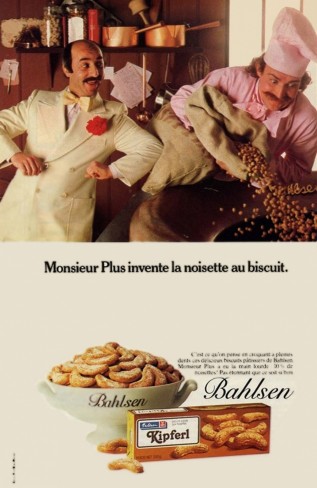[A translated/adapted excerpt from Franck Cochoy, De la curiosité, l’art de la séduction marchande, Paris, Armand Colin, 2011]
A box generally hides its content but simultaneously provides some clues about it. In postponing the discovery of what it shadows, packaging implements a triple economy of curiosity, desire and surprise. But along history, countless attempts made at opening packages ended up in changing the outcome of these experiments, and finally produced a dramatic reversal between the share of bad and good surprises to the benefit of seconds. What are the reasons and implications of this surprising reversal?
Historically, the packaging device was first seen as an opportunity for fraud. Indeed, in rejecting the assessment of its content after the moment of the market exchange, the public was entitled to suspect that opaque boxes served to break the match between the advertised content and the actual one, for the benefit of the merchant (Strasser, 1989). However and ironically, after an unprecedented reversal inherent to the device itself—it’s the first surprise of the device of surprise!—the package was very soon presented as a weapon liable to eradicate this fraud that one could have thought it was meant to serve. The packaging has indeed the incredible power to teach more about its content than what this content can teach to us itself. Indeed, the words and numbers on a label can provide information on a product that any sensory experience of the same naked product will never give us, as the details of its composition or the indication of its origin. In the early twentieth century, as part of large national legislation on quality and product safety—1905 Law on the Repression of Fraud in France, 1906 Pure Food and Drug Act in the United States, and so on—the law has turned this type of information in legal obligations and contractual commitments: instead of functioning as an opportunity for fraud, packaging thus became one of the best tools to prevent it. The label on the boxes, once signed by the manufacturer, provided all the means to find and punish the perpetrators of fraud so that now, trusting packaging is the law of the market, and rejecting it the exception.
From this point of view, the social sciences have lagged behind the course of markets. Economic sociology, especially the French literature on the sociology of quality, has given considerable attention to the issue of information asymmetries in focusing on the economy of quality (Karpik, 2010) and the dynamics of qualifying products (Callon et al. 2000; Cochoy, 2002). In economics, information asymmetry is represented as a tool available to the seller who always plays at the expense of the purchaser. This type of “opportunistic” behavior is a perversion of the market mechanism: because it is assumed that the actors are opportunists, the one who hides something to his partner’s sight invariably benefits to deceive him for his own benefit, and get a larger profit. We know the canonical example of the market for “lemons,” i.e. used cars: on such a market the seller knows more than the buyer about the product and, if the latter is deficient, he will not hesitate to conceal this information to sell it to the price of standard used cars and thus make a gain which is at least questionable (Akerlof, 1970). In other words, for the economics of quality, in a market populated by rational actors “surprise” is implicitly regarded as fatally “bad”.
However, on these issues, economics and even more sociology intervened too late. Even Akerlof, when writing his famous article, conceded that practitioners did not wait for the formulation of his model for establishing a diagnosis and develop the solutions he honestly gives the list: Akerlof cites the guarantees, brands, chains, certification systems—and “even the Nobel Prize, to some extent”, the future recipient says in a mischievous note, as if he was clearly reluctant to recognize the merits of some winners his article came to challenge the glory! It’s really bad luck: for once an economist seemed to gather the unanimous praise from sociologists, to the point of seeing the latter surprisingly admire the virtues of a hardcore heuristic model, perfectly stylized and indexed on a series of those simplifying hypothesis that economics loves and sociology hates, no one—except the brilliant Akerlof himself!—had noticed that this model was outdated at the very moment of its conception. It is not necessary to be a literate market historian to know that the guarantees, brands, chains and labels Akerlof refers to are not inventions of his own, but readily available antidotes, for a long time, to counter the occurrence of opportunism in a situation of information asymmetry[1]. In short, the economics and sociology of quality are of little use: their reasoning and their results are perfectly fair and even illuminating, but they are also fully redundant vis-à-vis what the actors (with the possible exception of some colleagues of Akerlof) knew and did already, well before their formulation.[2]
However, it is surprising to observe how Akerlof’s work neglected the potential of surprise, in a positive sense this time. Yet, the setting of good surprises is the only asymmetry of information upon which professionals still have the latitude to play on, once the bad surprise of fraud is seriously impeded by the mechanisms of contractual commitments attached to modern packaging. Now, “good surprise” gives another meaning to the asymmetries of information as desirable by others, both on the supply side—see the repeated use of games contests, gifts, “bonuses” in order to praise “novelty”—and the demand side, as shown by the pleasure we all experience, each time we receive a packaged gift.
Packaging (or the setting of surprise that goes with it) clearly involves a deliberate (or forced) exploitation of the asymmetry of information, but it shows that economic calculation, instead of necessarily leading the players to favor the lowest bid, may instead inspire them to be honest and/or generous. In that case and surprisingly, taking advantage of the asymmetry of information asymmetry leads not to organize a loss, but rather obtain a preservation or at best an enhancement of quality.
The preservation of quality is the most common case. It occurs when the surprise[3] is the lack of surprise: this is the situation where the opening of a package confirms the accuracy of the statements intended to describe its content, as if the actors had not yielded to the opportunistic temptation. In the second case, the box does not contain exactly what the packaging promises, but this shift occurs in favor of the buyer in the form of a “good surprise.” This may take the form of a surplus of quantity—the package contains more units than what is announced on the product label—but also the form of gain which is less frequent or difficult to estimate when the product is accompanied by or adorned with more virtues, objects or services that the label could or would announce it. In all these cases, it is as if the logic of the “efficiency wage” dear to labor economists migrated toward the market for goods and services, in the form of an “efficiency bonus.” In the very same way that, on the job market, the payment of higher wages than the average market price allows the employer to expect an increased investment from its recruits (Shapiro and Stiglitz, 1984), exceeding the promise of a package bets on a reinforced attachment from customers. Who has not experienced the satisfaction of finding an ordinary product purchased at a modest price much better than the packaging and/or the prize could foreshadow? We should note however that often the actors do not resist the temptation to disclose the logic of this bet since its implementation (like a secret we cannot keep), either directly with mentions such as “x% extra free product,” or indirectly, and in a form perhaps more rhetorical than literal illustrated by the unspeakable tics of “Mr. Plus,” the hero of a famous ad of Bahlsen cookie company.
But most often, what the use of packaged information asymmetries involves is neither an error of assessment which consists in taking a product of poor quality (in the case of Akerlof) or a more abundant or better product (in the cases I just mentioned) for the standard product, nor the hope of an attachment of the consumer in case of satisfaction, but the excitement aroused by the promise of packaging and the obstacles that the latter yet paves on in his way. This gap creates a differential whose occurrence often raises the desire to fill it. In this case, the extra value attached to the asymmetry of information is quite different from the pattern described by Akerlof, both on the supply and demand sides. On the supply side, this surplus does not rest in the negative or positive change in the content quality but in the packaging game of curiosity. On the demand side, the surplus mobilizes another kind of asymmetry than the asymmetry of information dear to classical economics. While it is not perceived by the customer, the new asymmetry is instead approached in the form of waiting for “something different and desirable” which remains if not a mystery, at least one object worthy of discovery. The added value comes here not of a particular input, instead the input of novelty or the hope of novelty. There lies a trick close to the excitement of striptease, which brings the viewer to engage in a sequence of pleasurable expectation, discovery, shared and revelation.
References
- Akerlof, G. A. (1970), “The market for ‘Lemons’: Quality Uncertainty and the Market Mechanism,” Quarterly Journal of Economics, Vol. 84, No. 3 (August), pp. 488-500.
- Callon, M., Méadel, C. and Rabeharisoa, V. (2002), “The economy of qualities,” Economy and Society, Vol. 31, No. 2, May, pp. 194-217.
- Chiappori, P. & Salanie, B. (2000Cochoy, F. (2002), Une sociologie du packaging, ou l’âne de Buridan face au marché, Paris, Presses Universitaires de France.
- Cochoy, F. (2002), Une sociologie du packaging, ou l’âne de Buridan face au marché, Paris, Presses Universitaires de France.
- Hemenway, D. (1990), “Propitious selection,” The Quarterly Journal of Economics, vol. 105, pp. 1063-1069.
- Karpik, L. (2010), Valuing the Unique: The Economics of Singularities, Princeton University Press.
- Presbrey, F. (1929), History and development of advertising, Garden City, N.Y, Doubleday.
- Shapiro, Carl & Stiglitz, Joseph E. (1984), “Equilibrium unemployment as a worker discipline device,” American Economic Review, Vol. 74, No. 3, pp. 433-444.
- Strasser, S. (1989), Satisfaction Guaranteed, The making of the American mass market, New York, Pantheon Books.
- We could add a reference to the considerable efforts made by professional advertisers to ban deceptive advertising practices and even make “honest advertising” a technique where the reliability of the commitments is less an end in itself but a means for greater business efficiency, as has attempted to show John E. Powers, one of the founders of modern advertising, who was instrumental in the introduction of practices such as the free trial of product or the reimbursement in case of dissatisfaction (Presbrey, 1929, p. 302, et seq.).
- In this respect, economists were quicker than sociologists to draw the conclusions from this fact and to “move forward,” in focusing on particular situations that contradict adverse selection: they have shown the existence of the opposite phenomenon—called “propitious selection” or “advantageous selection”—that leads for example those who least need insurance to be the first who to acquire one, due to a positive relationship between the aversion for risk and prudence in everyday life (Hemenway, 1990; Chiappori and Salanie, 2000; Eisenhauer, 2004).
- From the perspective of the economist, who is very surprised not to see calculation led at its climax in spite of such an opportunity!

